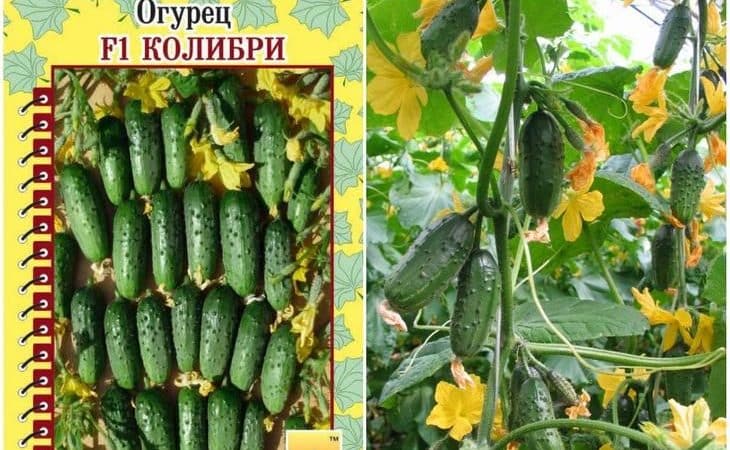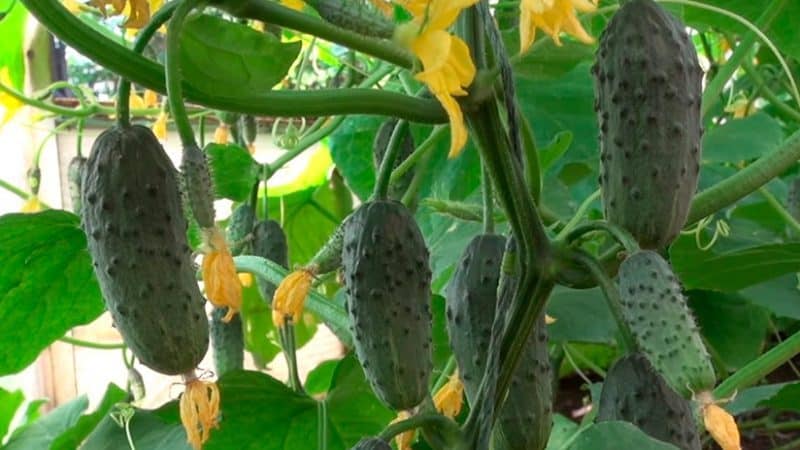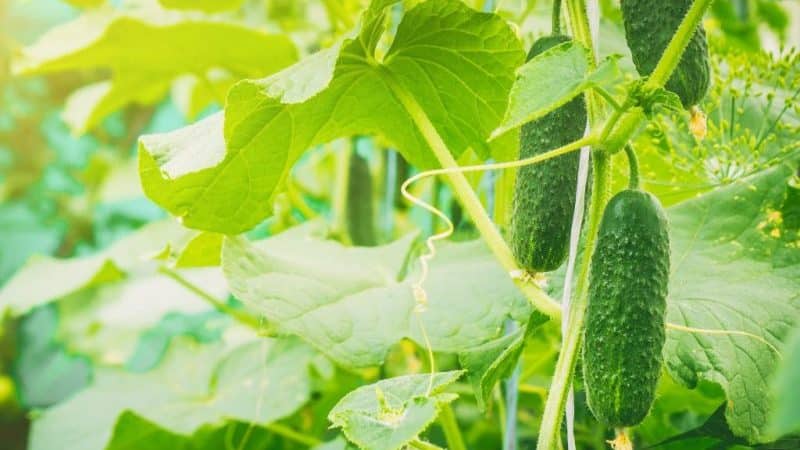Surprisingly productive cucumber “Hummingbird” for pickles and fresh consumption
Thanks to the selection of new crops, it is now possible to grow vegetables not only in beds and greenhouses, but also on balconies and window sills. These “household items” include the cucumber hybrid Kolibri with excellent taste, suitable for harvesting for future use and eating fresh.
Description of the hybrid
In the state register, the crop is described as an indeterminate hybrid with weak growth, bred to produce gherkins and pickles. Does not require daily harvesting, as the fruits are not prone to overgrowth. It is recommended to pick vegetables every other day so as not to interfere with the setting of new fruits and the ripening of existing ones.
Distinctive features
The most important indicators of a hybrid:
- the first harvest is harvested after 40 days;
- suitable for planting both in open ground and in greenhouses;
- It is resistant to pests, diseases and adverse weather conditions.
See the photo below for the shape of the fruit.

Composition, properties, benefits, calorie content
The vegetable is known for its beneficial qualities for the body due to the content of vitamins B, C, folic acid and trace elements: iron, potassium, iodine, silver, calcium and many others.
Despite the fact that their amount is only 2-5%, cucumber has a beneficial effect on the cardiovascular system, lowers blood pressure, inhibits the formation of kidney stones, and helps cleanse the body of toxins. Famous for its rejuvenating and skin-improving properties.
Reference. The peel contains a lot of fiber, so cucumber is considered the main vegetable for those who want to lose weight. Nutritional value is only 14 kcal per 100 g of product.
Characteristics
Hummingbird cucumber is a parthenocarpic, highly productive plant. It is characterized by a highly developed root system of a taproot type with numerous lateral branches. The creeping, curly, spreading stem is distinguished by tufted weaving and rapidly developing lateral shoots and shoots. Each node is capable of forming up to eight ovaries. The tendrils that form help the plant to cling to support on its own. The leaves are small, heart-shaped and bright green.
The fruits are characterized by pimples and light green stripes on the skin. The shape is short, like gherkins, cylindrical, tapering towards the stalk. The length of the fruit is 5-8 cm, in diameter - 3-3.5 cm. The weight reaches 60-80 g. The pulp is without voids and bitterness, crispy, dense. The seeds are usually small or absent.
Has increased fruit production - a bed of cucumbers with an area of 1 square. m can produce 9-11 kg of vegetables. To obtain gherkins, harvesting is carried out every other day; pickles are collected daily.
How to grow your own
The hummingbird is adapted to any soil, as long as it is saturated with humus and well aerated. The good thing about the hybrid is that it can grow not only in vegetable gardens and greenhouses, but is also suitable for balconies and flowerpots.

Even a beginner can grow a vegetable on his own; you just need to choose the most appropriate sowing method and observe the growing conditions.
Planting by seeds and seedlings
The site where it is planned to grow cucumbers is prepared in the fall. To do this, it is dug up and fertilized with phosphorus-potassium and organic fertilizers. If the bed had to be prepared in the spring, when digging, add compost, humus, and complex mineral fertilizers, according to the instructions. Cucumber is a heat-loving vegetable, so choose a place that is sunny and protected from adverse weather conditions.
The optimal time for planting seeds in open ground is from the end of April to the second half of May, depending on the region. If you sow earlier, the shoots will not receive sufficient light, which will lead to the plant stretching and weakening.
Later sowing can lead to a shorter growing season and reduce yields several times. In an open area, make 4-5 holes per 1 square. m. In protected ground, 2-3 plants are placed in the same volume.
Experienced gardeners recommend growing cucumbers using seedlings to achieve earlier fruit appearance.
To grow seedlings do the following:
- Prepare the seeds in advance by calibrating them, keeping them at low temperatures, and treating them in a solution of potassium permanganate.
- A solution is prepared from ash and nitroammophoska and water, and seeds placed in a cloth bag are dipped into it.
- A day later, the seeds are removed, washed under running water, and placed on a damp cloth for two days.
- After swelling, they are planted in separate containers.
Before planting seedlings in a permanent place, they are watered, fertilized, and when the ground warms up, they are planted in the ground.
The beds are placed at a distance of 65-70 cm from each other, holes are made in them at a distance of 20 cm, they are filled with water, they wait until it is absorbed into the ground, then they begin to plant seeds or seedlings.
Growing and care
After 6-7 leaves appear, the main stem is pinched - this increases the yield. As the bush grows, it is tied to a support, the beds are kept clean, and weeds are removed if necessary. In order to speed up the growth of fruits, the leaves are thinned out and those that shade the fruits are removed.
At night, young shoots are covered with film or other material in case the temperature drops.
Cucumber is a moisture-loving plant that requires regular watering and care. Before the plant begins to bloom, add 5 liters of water per square meter. m in dry weather and 2 liters after precipitation. During the fruiting period, the water rate is increased by 2-3 liters. It is better to water the plants in the morning, with warm water, so as not to overcool the roots. It is recommended to do this with a watering can and not with a hose; the soil is moistened with water, but not the plant itself.
To prevent the formation of a crust on the surface of the soil after watering, which slows down the development of stems, the soil around the roots is loosened. This is done as carefully as possible; the root system of cucumbers is located close to the surface of the soil and may be damaged when loosened.
The harvest is harvested as the fruits ripen; unpicked cucumbers prevent the formation of a new ovary.
Fertilizers are applied several times throughout the growth cycle. The first feeding is carried out two weeks after planting. For this purpose, mixtures containing potassium, nitrogen, and magnesium are used. An infusion of onion skins, diluted manure or chicken droppings, and fermented milk products are suitable as organic fertilizers. Fertilizers are applied at the root, at the rate of 1.5 liters per 1 square meter. m beds. To saturate the soil with potassium, use a solution of wood ash, adding 0.5 liters under each bush.
Features of cultivation and possible difficulties
A special feature of caring for Hummingbird cucumbers is the need to form and tie up the bushes; without this, the plant goes into wild growth and becomes low-yielding.
The short period of fruit ripening does not allow the use of heavy agrochemicals, otherwise the vegetables will grow toxic.
Diseases and pests
When favorable conditions for growing are created, the plant rarely suffers from cucumber mosaic and olive spot, as it has stable immunity to diseases.
The most typical diseases for Hummingbirds:
- anthracnose;
- bacteriosis;
- peronosporosis;
- white rot and sulfur.
To combat them, plants are sprayed with a solution of urea, copper oxychloride, as well as fungicides “Kurzat R”, “Acrobat MC”, “Ridomil MC”.
As a preventative measure, the bushes are treated with a solution consisting of laundry soap, iodine, milk, fermented milk products, and urea.
Typical pests include:
- thrips;
- ticks;
- aphids;
- bedbugs
To combat them, use “Confidor”, “Aktellik”, “Karate”, “Talstar” according to the instructions on the package.
In order to avoid damage to plants by pests, onions, garlic, and dill are planted between the bushes. To get rid of the larvae, the seeds are hardened before sowing and the ground is dug up.
Harvesting and application
The first harvest is harvested after about 40-42 days, then every two days. The morning or evening of a dry, sunny day is suitable for collection. Collect carefully so as not to damage the fruits, otherwise their shelf life will be reduced.

Vegetables separated from the stalks with a sharp knife are placed in containers or baskets, then stored in a cool, dry place with a temperature of about +5°C. Vegetables last for about a month, provided storage rules are followed.To preserve healthy, tasty vegetables for as long as possible, they are pickled and salted.
Advantages and disadvantages
Advantages of the Hummingbird hybrid:
- precocity;
- high productivity;
- excellent transportability;
- long fruit formation;
- immunity to disease;
- excellent taste;
- low maintenance requirements;
- not prone to overgrowth.
Disadvantages include:
- the need to form a bush and tie it up;
- inability to collect seeds yourself.
Reviews
Reviews from gardeners confirm the excellent taste of the Hummingbird cucumber, the ability to grow in beds and greenhouses, in pots and on balconies.
Arthur, Saratov: “The hummingbird is quite interesting to look at and to raise. If climatic conditions permit, it can be grown all year round. Hybrid parthenocarpic cucumbers, which means the vegetable is self-pollinating, i.e. Insects are not needed for pollination. And this is a huge plus, because if the weather is bad, few insects fly, but this hybrid does not depend on them. The cucumber is also interesting because it grows in a bunch and its yield from one bush is amazing. He claims that if he decides to grow this vegetable, no one will be disappointed.”
Maria Ivanovna from the Moscow region recommends Kolibri to those who have not yet decided on its choice: “When I bought the seeds, I didn’t think that they would sprout so well. Planted in open ground. The ovary appeared quickly, the first cucumbers were tried already on the fortieth day. They turned out crispy, aromatic, pimply. They bore fruit until late autumn, and there was almost no need to spray them against pests. Not only was there enough for us, but we also distributed it to our neighbors.”
Conclusion
Hybrid Hummingbird is a competitive hybrid with excellent taste, strong immunity, and good keeping quality. This makes it in demand for many gardeners and farms. Thanks to its unpretentiousness, it is able to produce an excellent harvest.